Copyright © 2003 Prentice-Hall, Inc. MARKETING course Instructor





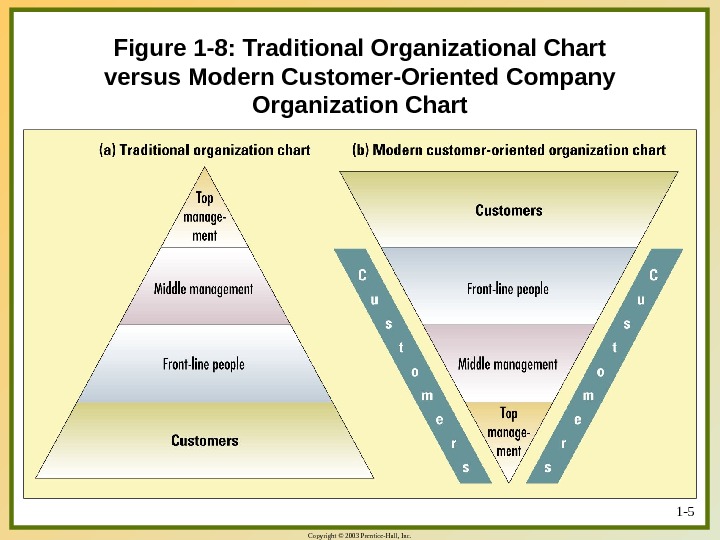
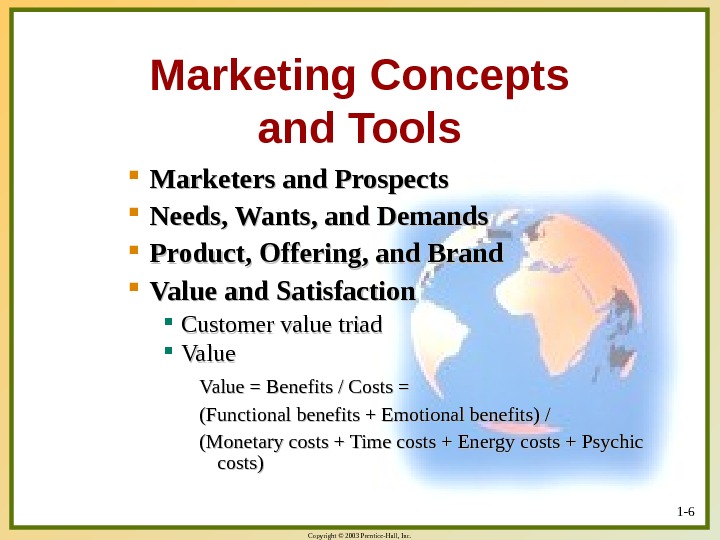
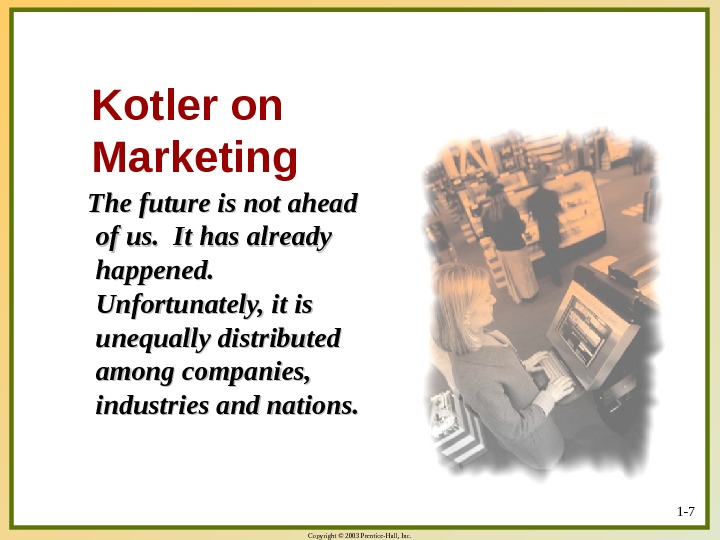
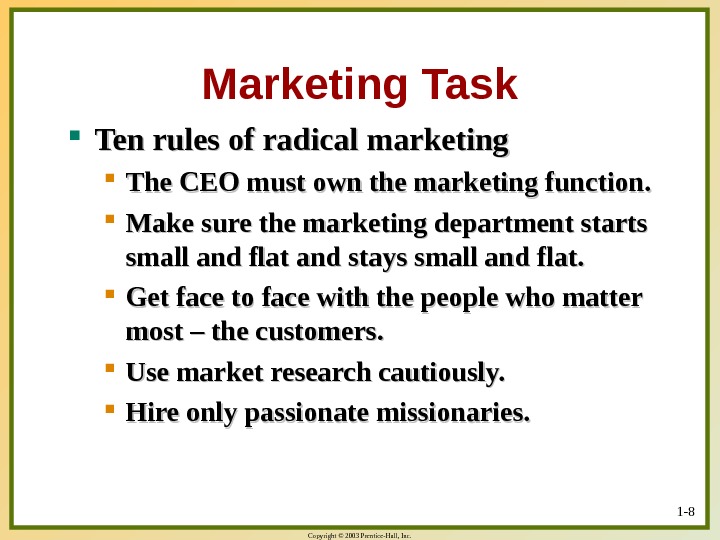
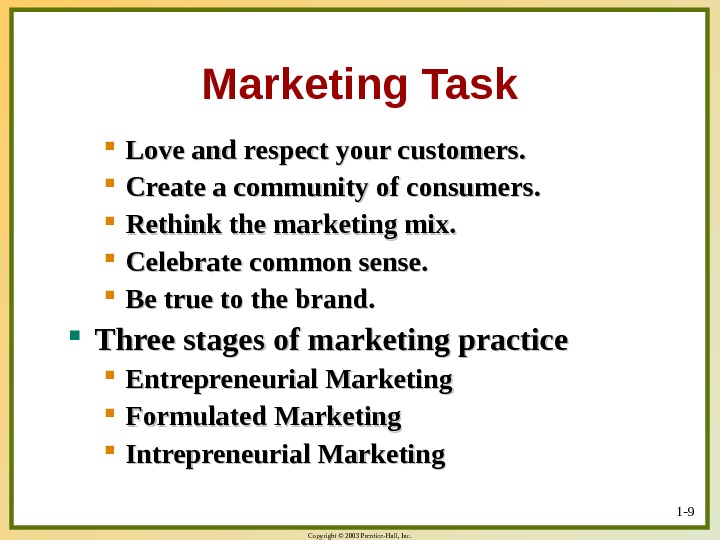

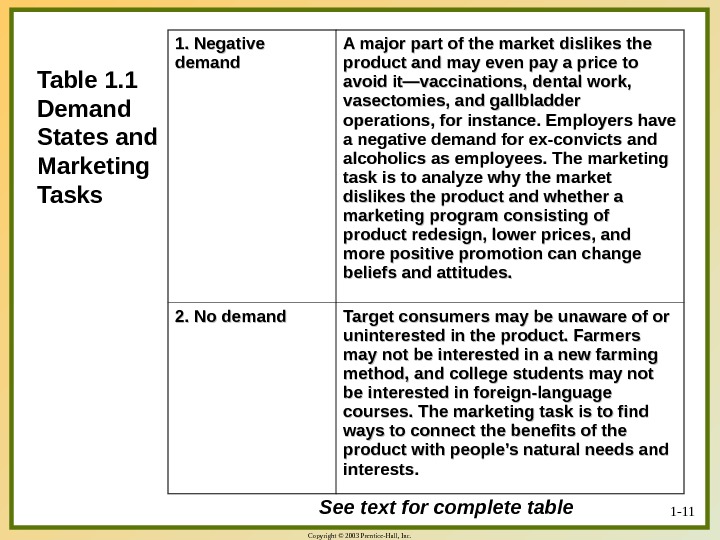

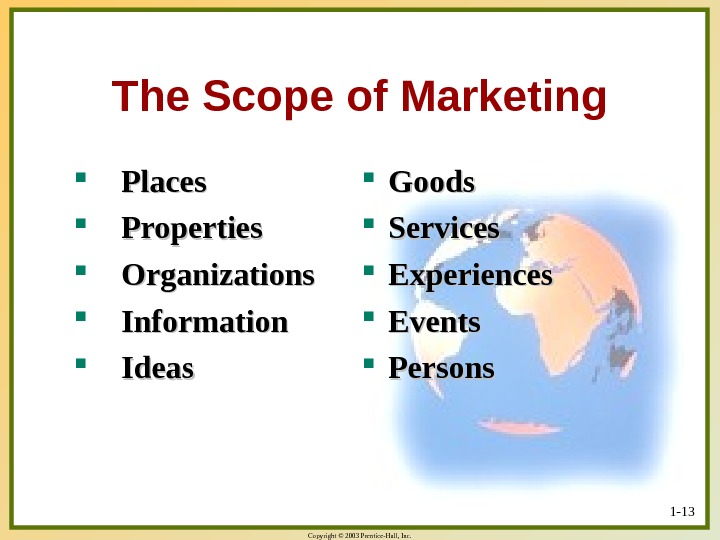
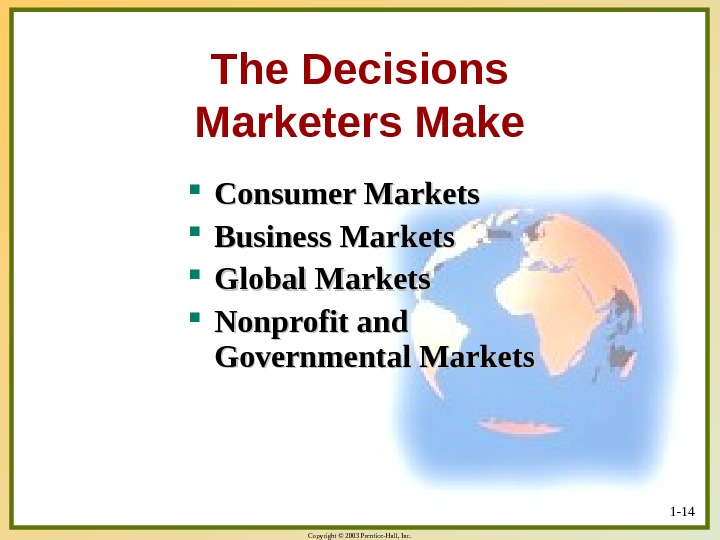
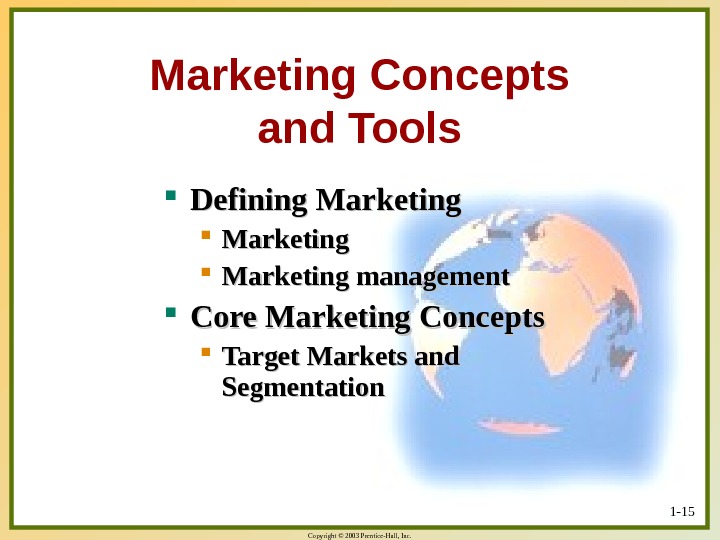



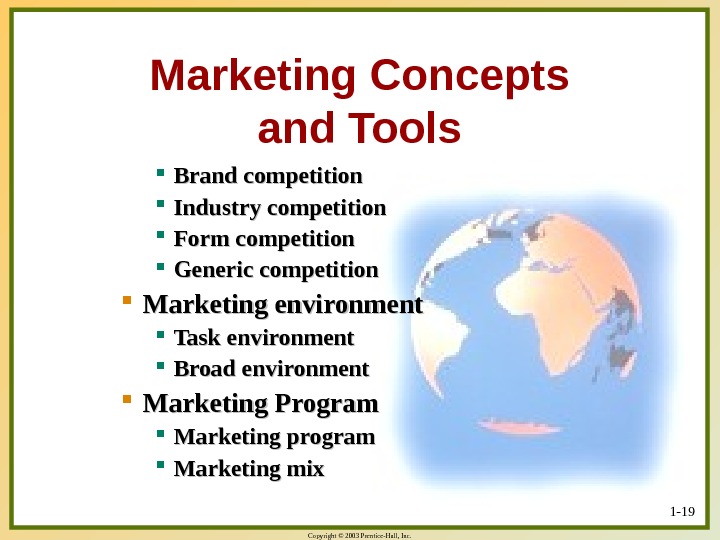

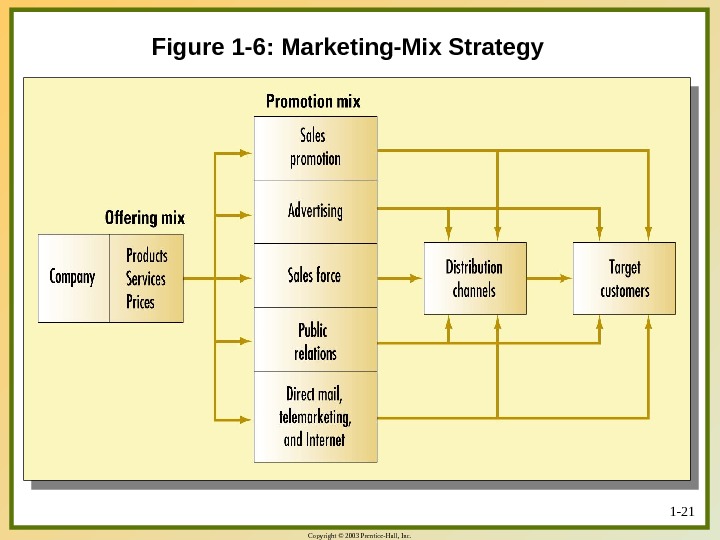
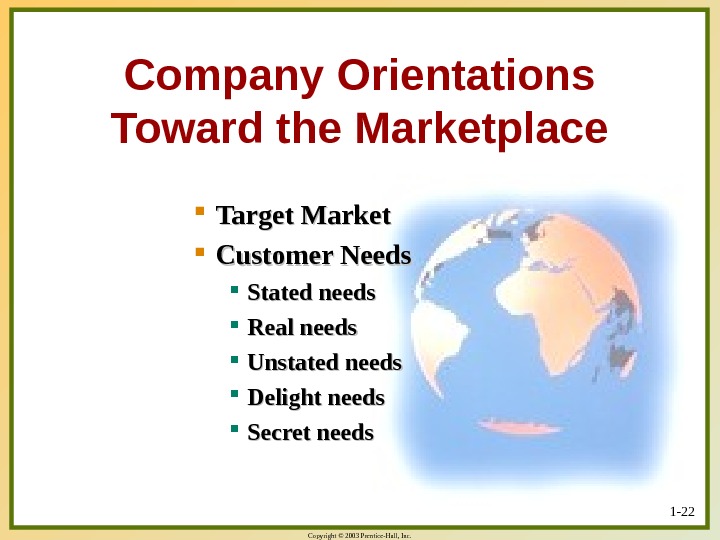
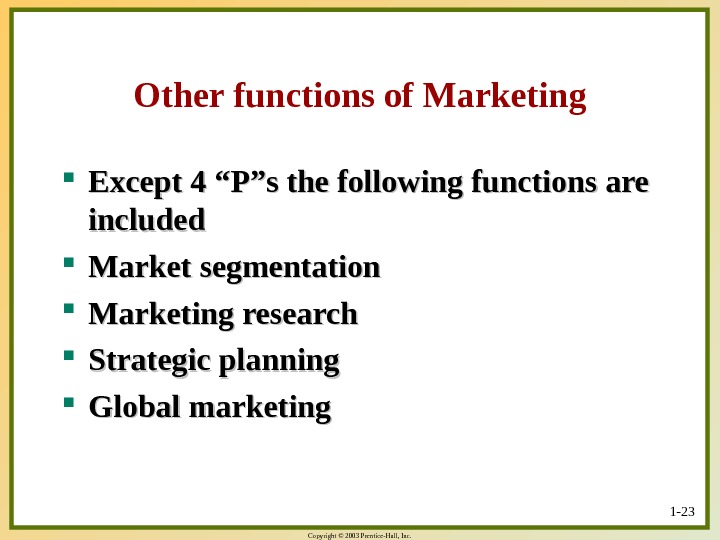
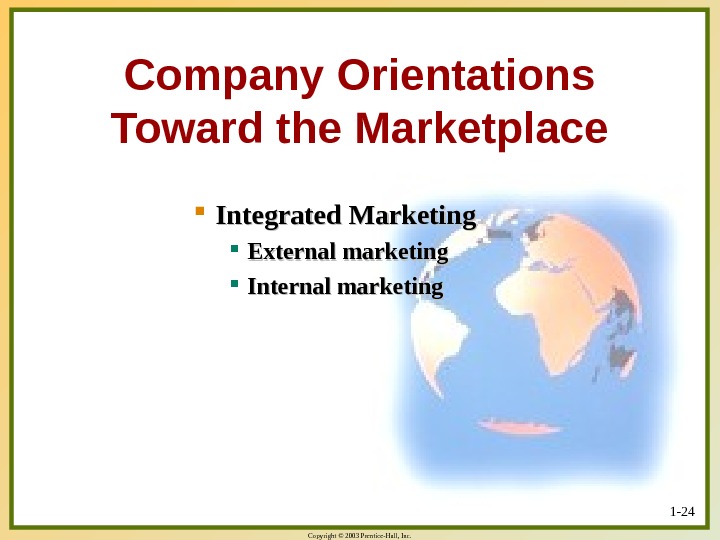
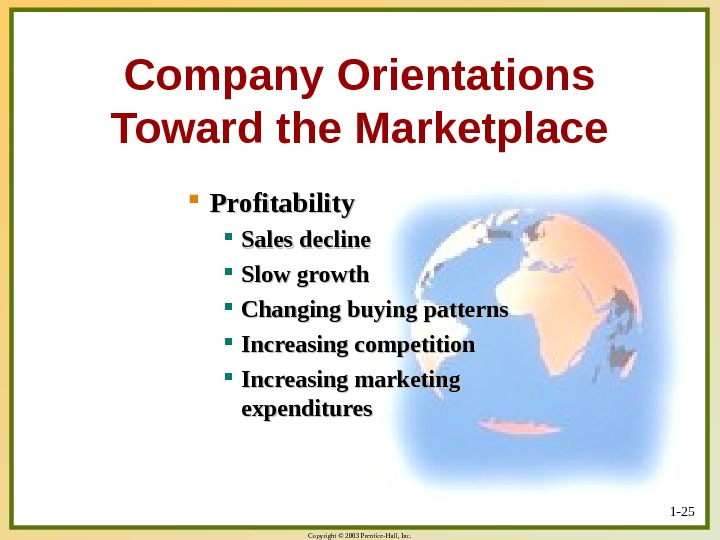
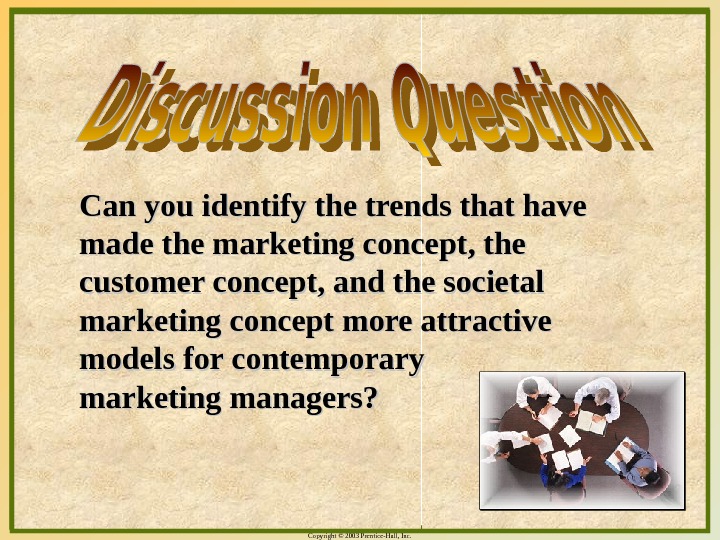
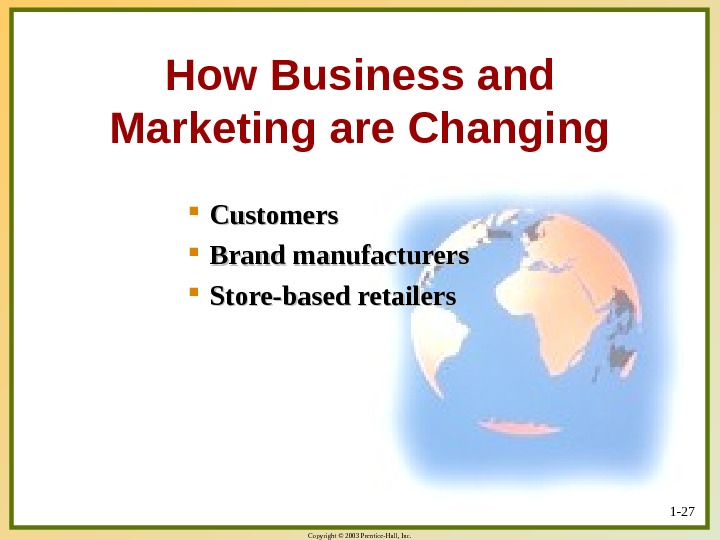
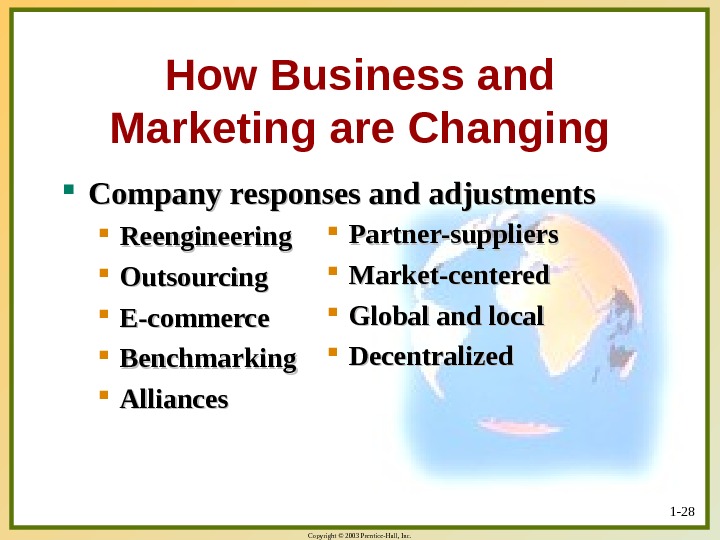
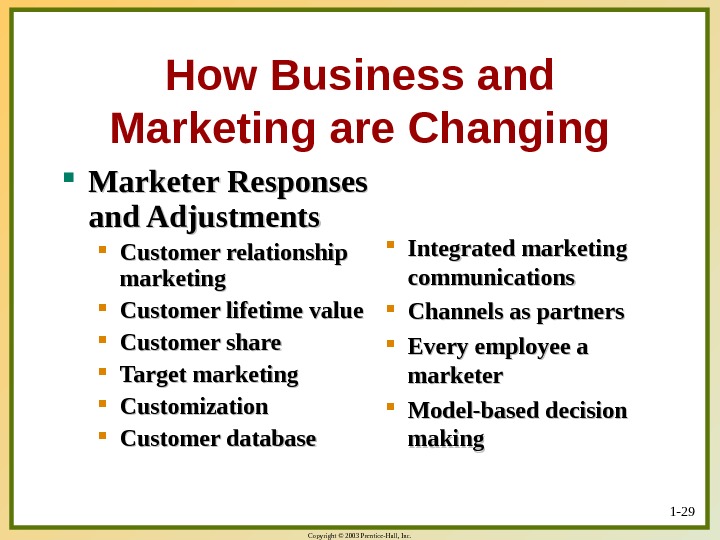
topic_1_marketing.ppt
- Размер: 6.9 Mегабайта
- Количество слайдов: 29
Описание презентации Copyright © 2003 Prentice-Hall, Inc. MARKETING course Instructor по слайдам
 Copyright © 2003 Prentice-Hall, Inc. MARKETING course Instructor Didar Ilyassov Topic 1 Introduction to Marketing 1 —
Copyright © 2003 Prentice-Hall, Inc. MARKETING course Instructor Didar Ilyassov Topic 1 Introduction to Marketing 1 —
 Copyright © 2003 Prentice-Hall, Inc. Say hello to Marketing! Marketing and Management Historical background of Marketing in US 1. Production concept (1900 -1930) 2. Product concept (1930 -1950) 3. Selling Concept (1950 -1970) 4. Marketing Concept (1970 -1990) 5. Societal Marketing Concept (from 1990) 1 —
Copyright © 2003 Prentice-Hall, Inc. Say hello to Marketing! Marketing and Management Historical background of Marketing in US 1. Production concept (1900 -1930) 2. Product concept (1930 -1950) 3. Selling Concept (1950 -1970) 4. Marketing Concept (1970 -1990) 5. Societal Marketing Concept (from 1990) 1 —
 Copyright © 2003 Prentice-Hall, Inc. 1 — 3 Figure 1 -7: Contrasts Between the Sales Concept and the Marketing Concept
Copyright © 2003 Prentice-Hall, Inc. 1 — 3 Figure 1 -7: Contrasts Between the Sales Concept and the Marketing Concept
 Copyright © 2003 Prentice-Hall, Inc. 1 — 4 Figure 1 -10: The Customer Concept. Company Orientations Toward the Marketplace
Copyright © 2003 Prentice-Hall, Inc. 1 — 4 Figure 1 -10: The Customer Concept. Company Orientations Toward the Marketplace
 Copyright © 2003 Prentice-Hall, Inc. 1 — 5 Figure 1 -8: Traditional Organizational Chart versus Modern Customer-Oriented Company Organization Chart
Copyright © 2003 Prentice-Hall, Inc. 1 — 5 Figure 1 -8: Traditional Organizational Chart versus Modern Customer-Oriented Company Organization Chart
 Copyright © 2003 Prentice-Hall, Inc. 1 — 6 Marketing Concepts and Tools Marketers and Prospects Needs, Wants, and Demands Product, Offering, and Brand Value and Satisfaction Customer value triad Value = Benefits / Costs = (Functional benefits + Emotional benefits) / (Monetary costs + Time costs + Energy costs + Psychic costs)
Copyright © 2003 Prentice-Hall, Inc. 1 — 6 Marketing Concepts and Tools Marketers and Prospects Needs, Wants, and Demands Product, Offering, and Brand Value and Satisfaction Customer value triad Value = Benefits / Costs = (Functional benefits + Emotional benefits) / (Monetary costs + Time costs + Energy costs + Psychic costs)
 Copyright © 2003 Prentice-Hall, Inc. 1 — 7 The future is not ahead of us. It has already happened. Unfortunately, it is unequally distributed among companies, industries and nations. Kotler on Marketing
Copyright © 2003 Prentice-Hall, Inc. 1 — 7 The future is not ahead of us. It has already happened. Unfortunately, it is unequally distributed among companies, industries and nations. Kotler on Marketing
 Copyright © 2003 Prentice-Hall, Inc. 1 — 8 Marketing Task Ten rules of radical marketing The CEO must own the marketing function. Make sure the marketing department starts small and flat and stays small and flat. Get face to face with the people who matter most – the customers. Use market research cautiously. Hire only passionate missionaries.
Copyright © 2003 Prentice-Hall, Inc. 1 — 8 Marketing Task Ten rules of radical marketing The CEO must own the marketing function. Make sure the marketing department starts small and flat and stays small and flat. Get face to face with the people who matter most – the customers. Use market research cautiously. Hire only passionate missionaries.
 Copyright © 2003 Prentice-Hall, Inc. 1 — 9 Marketing Task Love and respect your customers. Create a community of consumers. Rethink the marketing mix. Celebrate common sense. Be true to the brand. Three stages of marketing practice Entrepreneurial Marketing Formulated Marketing Intrepreneurial Marketing
Copyright © 2003 Prentice-Hall, Inc. 1 — 9 Marketing Task Love and respect your customers. Create a community of consumers. Rethink the marketing mix. Celebrate common sense. Be true to the brand. Three stages of marketing practice Entrepreneurial Marketing Formulated Marketing Intrepreneurial Marketing
 Copyright © 2003 Prentice-Hall, Inc. 1 — 10 The Scope of Marketing: typically seen as the task of creating, promoting, and delivering goods and services to consumers and businesses. -as business philosophy is oriented on customer satisfaction
Copyright © 2003 Prentice-Hall, Inc. 1 — 10 The Scope of Marketing: typically seen as the task of creating, promoting, and delivering goods and services to consumers and businesses. -as business philosophy is oriented on customer satisfaction
 Copyright © 2003 Prentice-Hall, Inc. 1 — 11 Table 1. 1 Demand States and Marketing Tasks 1. Negative demand A major part of the market dislikes the product and may even pay a price to avoid it—vaccinations, dental work, vasectomies, and gallbladder operations, for instance. Employers have a negative demand for ex-convicts and alcoholics as employees. The marketing task is to analyze why the market dislikes the product and whether a marketing program consisting of product redesign, lower prices, and more positive promotion can change beliefs and attitudes. 2. No demand Target consumers may be unaware of or uninterested in the product. Farmers may not be interested in a new farming method, and college students may not be interested in foreign-language courses. The marketing task is to find ways to connect the benefits of the product with people’s natural needs and interests. See text for complete table
Copyright © 2003 Prentice-Hall, Inc. 1 — 11 Table 1. 1 Demand States and Marketing Tasks 1. Negative demand A major part of the market dislikes the product and may even pay a price to avoid it—vaccinations, dental work, vasectomies, and gallbladder operations, for instance. Employers have a negative demand for ex-convicts and alcoholics as employees. The marketing task is to analyze why the market dislikes the product and whether a marketing program consisting of product redesign, lower prices, and more positive promotion can change beliefs and attitudes. 2. No demand Target consumers may be unaware of or uninterested in the product. Farmers may not be interested in a new farming method, and college students may not be interested in foreign-language courses. The marketing task is to find ways to connect the benefits of the product with people’s natural needs and interests. See text for complete table
 Copyright © 2003 Prentice-Hall, Inc. 1 — 12 Can you name a category of products for which your negative feelings have softened? What precipitated this change?
Copyright © 2003 Prentice-Hall, Inc. 1 — 12 Can you name a category of products for which your negative feelings have softened? What precipitated this change?
 Copyright © 2003 Prentice-Hall, Inc. 1 — 13 The Scope of Marketing Places Properties Organizations Information Ideas Goods Services Experiences Events Persons
Copyright © 2003 Prentice-Hall, Inc. 1 — 13 The Scope of Marketing Places Properties Organizations Information Ideas Goods Services Experiences Events Persons
 Copyright © 2003 Prentice-Hall, Inc. 1 — 14 The Decisions Marketers Make Consumer Markets Business Markets Global Markets Nonprofit and Governmental Markets
Copyright © 2003 Prentice-Hall, Inc. 1 — 14 The Decisions Marketers Make Consumer Markets Business Markets Global Markets Nonprofit and Governmental Markets
 Copyright © 2003 Prentice-Hall, Inc. 1 — 15 Marketing Concepts and Tools Defining Marketing management Core Marketing Concepts Target Markets and Segmentation
Copyright © 2003 Prentice-Hall, Inc. 1 — 15 Marketing Concepts and Tools Defining Marketing management Core Marketing Concepts Target Markets and Segmentation
 Copyright © 2003 Prentice-Hall, Inc. 1 — 16 Figure 1 -1: A Simple Marketing System
Copyright © 2003 Prentice-Hall, Inc. 1 — 16 Figure 1 -1: A Simple Marketing System
 Copyright © 2003 Prentice-Hall, Inc. 1 — 17 Figure 1 -2: Structure of Flows in a Modern Exchange Economy
Copyright © 2003 Prentice-Hall, Inc. 1 — 17 Figure 1 -2: Structure of Flows in a Modern Exchange Economy
 Copyright © 2003 Prentice-Hall, Inc. 1 — 18 Marketing Concepts and Tools Relationships and Networks Relationship marketing Marketing network Marketing Channels Supply Chain Competition
Copyright © 2003 Prentice-Hall, Inc. 1 — 18 Marketing Concepts and Tools Relationships and Networks Relationship marketing Marketing network Marketing Channels Supply Chain Competition
 Copyright © 2003 Prentice-Hall, Inc. 1 — 19 Marketing Concepts and Tools Brand competition Industry competition Form competition Generic competition Marketing environment Task environment Broad environment Marketing Program Marketing program Marketing mix
Copyright © 2003 Prentice-Hall, Inc. 1 — 19 Marketing Concepts and Tools Brand competition Industry competition Form competition Generic competition Marketing environment Task environment Broad environment Marketing Program Marketing program Marketing mix
 Copyright © 2003 Prentice-Hall, Inc. 1 — 20 Figure 1 -5: The Four P Components of the Marketing Mix
Copyright © 2003 Prentice-Hall, Inc. 1 — 20 Figure 1 -5: The Four P Components of the Marketing Mix
 Copyright © 2003 Prentice-Hall, Inc. 1 — 21 Figure 1 -6: Marketing-Mix Strategy
Copyright © 2003 Prentice-Hall, Inc. 1 — 21 Figure 1 -6: Marketing-Mix Strategy
 Copyright © 2003 Prentice-Hall, Inc. 1 — 22 Company Orientations Toward the Marketplace Target Market Customer Needs Stated needs Real needs Unstated needs Delight needs Secret needs
Copyright © 2003 Prentice-Hall, Inc. 1 — 22 Company Orientations Toward the Marketplace Target Market Customer Needs Stated needs Real needs Unstated needs Delight needs Secret needs
 Copyright © 2003 Prentice-Hall, Inc. Other functions of Marketing Except 4 “P”s the following functions are included Market segmentation Marketing research Strategic planning Global marketing 1 —
Copyright © 2003 Prentice-Hall, Inc. Other functions of Marketing Except 4 “P”s the following functions are included Market segmentation Marketing research Strategic planning Global marketing 1 —
 Copyright © 2003 Prentice-Hall, Inc. 1 — 24 Company Orientations Toward the Marketplace Integrated Marketing External marketing Internal marketing
Copyright © 2003 Prentice-Hall, Inc. 1 — 24 Company Orientations Toward the Marketplace Integrated Marketing External marketing Internal marketing
 Copyright © 2003 Prentice-Hall, Inc. 1 — 25 Company Orientations Toward the Marketplace Profitability Sales decline Slow growth Changing buying patterns Increasing competition Increasing marketing expenditures
Copyright © 2003 Prentice-Hall, Inc. 1 — 25 Company Orientations Toward the Marketplace Profitability Sales decline Slow growth Changing buying patterns Increasing competition Increasing marketing expenditures
 Copyright © 2003 Prentice-Hall, Inc. 1 — 26 Can you identify the trends that have made the marketing concept, the customer concept, and the societal marketing concept more attractive models for contemporary marketing managers?
Copyright © 2003 Prentice-Hall, Inc. 1 — 26 Can you identify the trends that have made the marketing concept, the customer concept, and the societal marketing concept more attractive models for contemporary marketing managers?
 Copyright © 2003 Prentice-Hall, Inc. 1 — 27 How Business and Marketing are Changing Customers Brand manufacturers Store-based retailers
Copyright © 2003 Prentice-Hall, Inc. 1 — 27 How Business and Marketing are Changing Customers Brand manufacturers Store-based retailers
 Copyright © 2003 Prentice-Hall, Inc. 1 — 28 How Business and Marketing are Changing Company responses and adjustments Reengineering Outsourcing E-commerce Benchmarking Alliances Partner-suppliers Market-centered Global and local Decentralized
Copyright © 2003 Prentice-Hall, Inc. 1 — 28 How Business and Marketing are Changing Company responses and adjustments Reengineering Outsourcing E-commerce Benchmarking Alliances Partner-suppliers Market-centered Global and local Decentralized
 Copyright © 2003 Prentice-Hall, Inc. 1 — 29 How Business and Marketing are Changing Marketer Responses and Adjustments Customer relationship marketing Customer lifetime value Customer share Target marketing Customization Customer database Integrated marketing communications Channels as partners Every employee a marketer Model-based decision making
Copyright © 2003 Prentice-Hall, Inc. 1 — 29 How Business and Marketing are Changing Marketer Responses and Adjustments Customer relationship marketing Customer lifetime value Customer share Target marketing Customization Customer database Integrated marketing communications Channels as partners Every employee a marketer Model-based decision making

